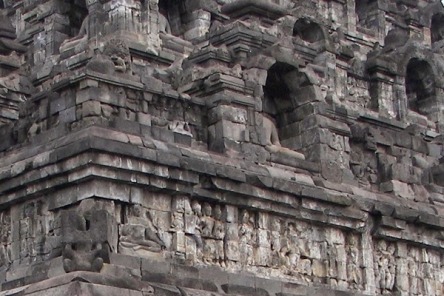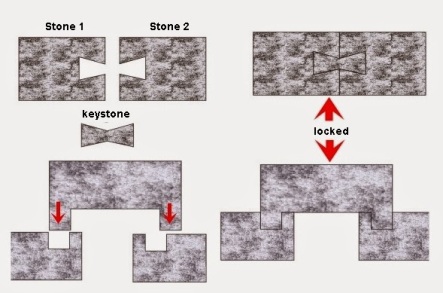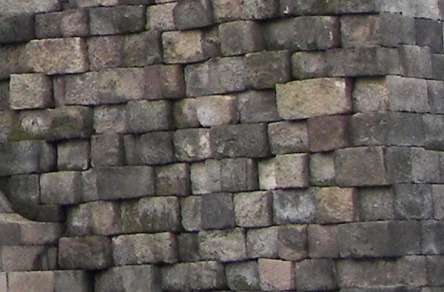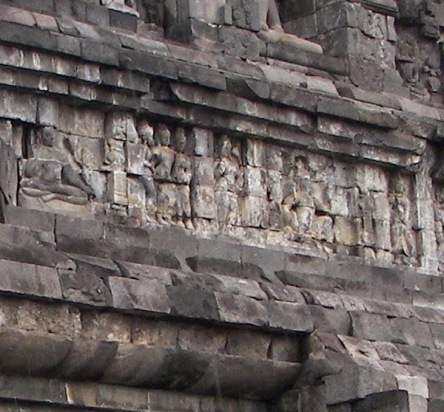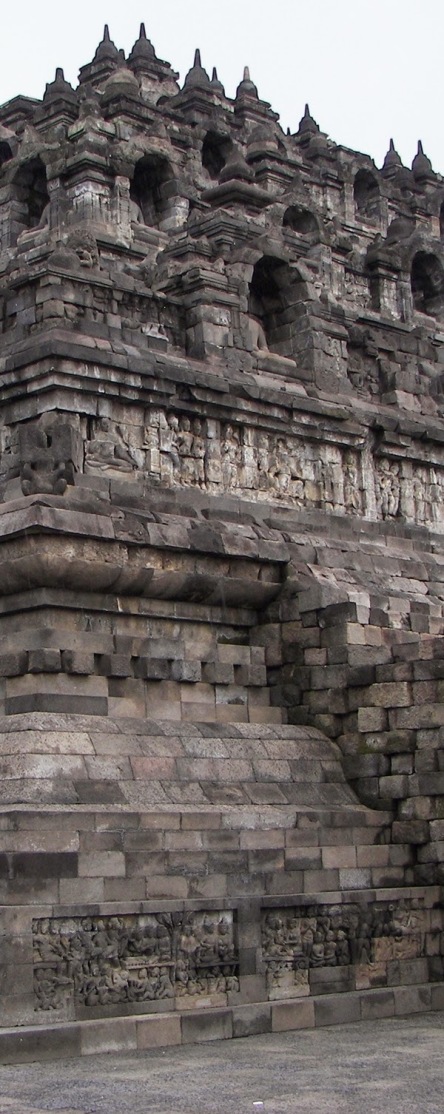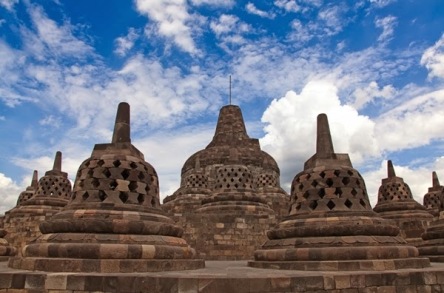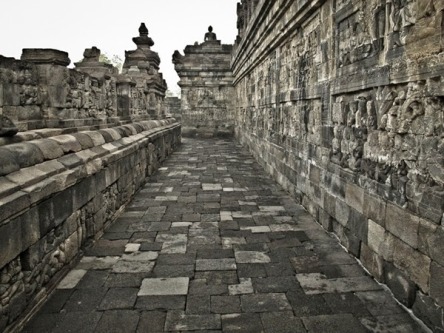All relief panels in Borobudur Mahayana Buddhism reflects, in which the top to symbolize the level of perfection. Bottom or Kamadhatu describe the behavior of a full rage and lust that causes a person to go to hell beasts. The middle section includes four levels called Rapadhatu, a man freed from lust and worldly things. While the top part includes three circular terraces that lead to the center of the dome is called Arupadhatu or dwelling place of the gods (nirvana).
Reporting from Indonesiatravel, there are reliefs Karmawibhangga actually buried in the ground and describe the actions of people who follow their lusts, such as gossiping, murder, torture, and rape. In fact, there are also scenes of sex in various positions. The opinions stated that the relief stockpiled because it is considered not appropriate on display, but some are of the opinion this closure solely for the sake of the stability of the position of the temple in order not to vanish.
In 1885, archaeologists JW Yzerman was to document and record these reliefs, then recorded on the original 1931 book is now in the National Museum, Jakarta. Whereas the original cliché stored in the Museum Amsterdam, Amsterdam given the status belonging to the Dutch Government, while the Government of Indonesia has a replica of the entire photo.
Around 1890-1891, part of which was covered entirely by the photographer opened Kasiyan Chepas to be photographed one by one. Volume of 13,000 cubic meters of rock was removed, then returned to its original position. To this day, the backfilled soil so it can not be seen. There are three panels in the southeastern part of the temple is open and closing again allegedly because the process is not perfect.
When you’ve reached the top of the temple, then rest and enjoy the beautiful scenery around it. At the top of Borobudur, you will find an empty space which is a symbol of perfection. As long as you are at the top, enjoy the mountain scenery and lush green surrounding, and feel the gentle breeze. You are free to take as many beautiful photographs desired object.
Local communities trust to mention that if you have been in the top of the temple and have a real desire, then your hands reach out and touch the figure of the Buddha in it, then your request will be realized. You may note some interesting stories of the carving of this temple relief, because there are many interesting stories in it. Make sure your tour guide tells a series of stories that contained in the stone carvings. If you are a writer or a poet, there may be a story that can inspire.
Another interesting thing of Borobudur is Manoreh Hill in the south. If you look closely, it appears contour hills shaped like a sleeping person as Borobudur was standing upright next to “the sleeping”.
Borobudur has 100 gutter-shaped makara (a statue of the elephant-headed fish) as well as water lines to add to the beauty of the temple. In the past, the rain water flowing through the makara will look like a fountain. Museum of Ocean Mercury will tell you about the history of trade between Indonesia and Africa in ancient times and how modern attempts to re-create the journey of this. In the Museum Karmawibhangga available resources complete this magnificent place.
Borobudur was similar to the Buddhist scriptures carved in the rock by the quality and quantity of bas-reliefs and the kind of story that qualified and equipped with statues and stupas are no less awesome. Borobudur has approximately 2672 relief panels that supposedly when stretched to reach a length of 6 kilometers. UNESCO recognized it as the ensemble even the largest and most comprehensive Buddhist reliefs in the world. Every scene and the story is a masterpiece of art sculpted intact and unusually high value.
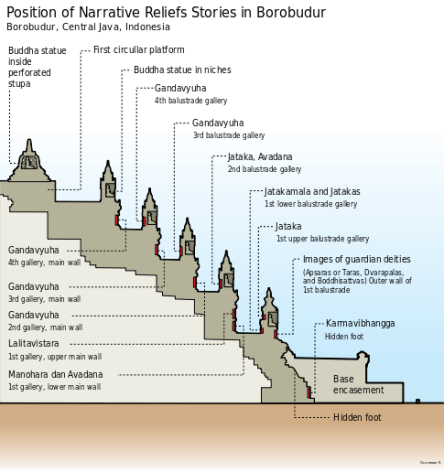 |
| Source image: Wikimedia |
There is a different technique for reading the reliefs on the walls of the temple, which is read according to the clockwise direction. This is known as mapradaksina (Javanese language) which is derived from Sanskrit meaning Daksina east. Beginning of the story starts and ends on the East side of the gate in each level. Borobudur has a ladder up in the four corners of the wind but it is estimated to go up the main staircase is in the east.
Relief in Borobudur Borobudur carved on several levels. The reliefs depict scenes taken from some of the silk, the story Karmawibhanga, Jatakamala, Awadana, Gandawyuha and Bhadracari.
Karmawibhangga is a relief depicting a story that has a correlation of cause and effect (karma). Kamadhatu zone, some Karmawibhangga reliefs depicting human passions, such as robbery, murder, torture, and humiliation. Not only depict evil deeds, Karmawibhanga Relief carved above 160 panels also illustrate causal doctrine of good works.
Each panel is not a narrative story (series) and contains certain stories of which describe the behavior of the Javanese society, including religious behavior, livelihood, social structure, fashion, equipment life, the types of flora and fauna, and forth. Overall it describes the human life cycle, namely: birth – life – death (samsara).
 |
| Karmawibhanga Relief (Image Source: wikimedia) |
Kamadhatu is a picture of a world inhabited by most people, or the world is still dominated by kama or “low desire”. Therefore this zone are at the lowest level of Borobudur and is now covered by a supporting foundation of the building so it is not visible (except on the South side open slightly). There are allegations that the closing of this zone due to strengthen the foundation of the building or structure. However, another conjecture states that it is to cover the obscene content of the relief. To see the relief in this zone, you can visit the Museum Karmawibhangga displaying photographs in Kamadhatu deliberately taken in order to still be able to be enjoyed by visitors.
Lalitawistara are reliefs depicting the Buddha’s history starts from the Buddha’s descent from heaven Tusita to the teachings of the first story he did in the Deer Park which is located near the city of Banaras. Relief Lalitawistara totaling 120 panels but not completely describe the story of the Buddha.
Lalitawistara is a series of beautifully carved reliefs story on temple walls in the hallway 1 level 2 Broadly speaking, Lalitawistara describes the life of Gautama Buddha at birth to get out of the palace and got enlightenment under the bodhi tree.
 |
| Lalitawistara Relief (Image Source: Wikimedia) |
Jataka and Awadana are reliefs of the Buddha before it was born as Prince Siddhartha. Carved on the second level of the temple (hall 1), relief is about kindness and self-sacrifice of the Buddha that he did in various forms of reincarnation, either as a human or animal. Good deeds is what distinguishes it from other creatures. Moreover, doing good is in the preparation stages of the business towards a higher level of Buddha.
Awadana is also contains figures Jataka story but not the Buddha but Sudhanakumara prince. The story on the relief Awadana Diwyawadana collected in the Book (the noble deed of divinity) and the Book Awadanasataka (hundred stories Awadana).
 |
| Awadana Diwyawadana Relief |
Gandawyuha is a row of neatly carved reliefs on the walls of Borobudur number 460 carved panels on the walls and balustrades. Bas-reliefs of the temple is spread over different levels depending.
Revolves around Sudhana, the son of a rich merchant who traveled in his quest for supreme knowledge or the real truth. Depiction on the panel-panels based on Mahayana Buddhist scripture entitled Gandawyuha. Meanwhile, for the lid, the story of the reliefs on the story of another, Bhadracari. This story is about the vows of Samantabhadra Bodhisattva Sudhana to make her life as a role model.
If you notice from the fifth to the seventh floor not appear reliefs on the walls. Level represents the nature of the so-called Arupadhatu (which means no tangible form or not). At this level, people are free from all desires and bond forms and shapes but have not reached nirvana. In Arupadhatu visible is stupas overlay in which there is a statue of Buddha.
At the highest level of Borobudur temple which has a total of 10 levels or is there a court of the greatest and highest stupa. In the largest stupa is a Buddha statue ever found imperfect or also called Unfinished Buddha that is now stored in the Museum Karmawibhangga.
Square Lay out with an overall size of 123 x 123 meters, Borobudur has no worship spaces like other temples. Borobudur has long hallways in the form of a narrow road, estimated as a place for Buddhist ceremonies walk around the temple to the right. Borobudur has six courts of a square, three round circular courtyard and a main stupa of the top court is located. The structure is basically a punden staircase, which is a form of original architecture from prehistoric Indonesia. Because of the uniqueness, beauty, historical value, and quality of high-value artworks are manifested in Borobudur, a Buddhist temple it is certainly worthy of the title as one of the masterpieces of the art of the high level of civilization archipelago.
 One of the best locations in the country to enjoy the atmosphere of this sunrise is at Borobudur. Located at an altitude of about 269 m above sea level, Borobudur gives a spectacular view of the sunrise time, ie, seeing the sun rising from behind a magnificent dusk of the Merapi. by Thrillseekr
One of the best locations in the country to enjoy the atmosphere of this sunrise is at Borobudur. Located at an altitude of about 269 m above sea level, Borobudur gives a spectacular view of the sunrise time, ie, seeing the sun rising from behind a magnificent dusk of the Merapi. by Thrillseekr













































